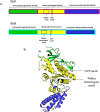Structural Basis for a Unique ATP Synthase Core Complex from Nanoarcheaum equitans
- PMID: 26370083
- PMCID: PMC4646375
- DOI: 10.1074/jbc.M115.677492
Structural Basis for a Unique ATP Synthase Core Complex from Nanoarcheaum equitans
Abstract
ATP synthesis is a critical and universal life process carried out by ATP synthases. Whereas eukaryotic and prokaryotic ATP synthases are well characterized, archaeal ATP synthases are relatively poorly understood. The hyperthermophilic archaeal parasite, Nanoarcheaum equitans, lacks several subunits of the ATP synthase and is suspected to be energetically dependent on its host, Ignicoccus hospitalis. This suggests that this ATP synthase might be a rudimentary machine. Here, we report the crystal structures and biophysical studies of the regulatory subunit, NeqB, the apo-NeqAB, and NeqAB in complex with nucleotides, ADP, and adenylyl-imidodiphosphate (non-hydrolysable analog of ATP). NeqB is ∼20 amino acids shorter at its C terminus than its homologs, but this does not impede its binding with NeqA to form the complex. The heterodimeric NeqAB complex assumes a closed, rigid conformation irrespective of nucleotide binding; this differs from its homologs, which require conformational changes for catalytic activity. Thus, although N. equitans possesses an ATP synthase core A3B3 hexameric complex, it might not function as a bona fide ATP synthase.
Keywords: ATP synthase; Nanoarchaeum equitans; archaea; catalytic core; crystal structure; evolution; protein complex.
© 2015 by The American Society for Biochemistry and Molecular Biology, Inc.
Figures














References
-
- Boyer P. D. (1997) The ATP synthase–a splendid molecular machine. Annu. Rev. Biochem. 66, 717–749 - PubMed
-
- Cross R. L., and Müller V. (2004) The evolution of A-, F-, and V-type ATP synthases and ATPases: reversals in function and changes in the H+/ATP coupling ratio. FEBS Lett. 576, 1–4 - PubMed
-
- Fillingame R. H. (1997) Coupling H+ transport and ATP synthesis in F1F0-ATP synthases: glimpses of interacting parts in a dynamic molecular machine. J. Exp. Biol. 200, 217–224 - PubMed
-
- Mitchell P. (1966) Chemiosmotic coupling in oxidative and photosynthetic phosphorylation. Biol. Rev. Camb. Philos. Soc. 41, 445–502 - PubMed
-
- Walker J. E., Fearnley I. M., Gay N. J., Gibson B. W., Northrop F. D., Powell S. J., Runswick M. J., Saraste M., and Tybulewicz V. L. (1985) Primary structure and subunit stoichiometry of F1-ATPase from bovine mitochondria. J. Mol. Biol. 184, 677–701 - PubMed
Publication types
MeSH terms
Substances
Associated data
- Actions
- Actions
- Actions
- Actions
- Actions
- Actions
- Actions
- Actions
- Actions
- Actions
- Actions
- Actions
- Actions
- Actions
- Actions
- Actions
- Actions
- Actions
- Actions
- Actions
- Actions
- Actions
LinkOut - more resources
Full Text Sources

